William Chalmers Raitt’s history of the Raitts
When he retired, William Chalmers Raitt, descended from Alexander Raitt of Scotland via New Brunswick, wanted to find out more about his ancestors. He followed up on the New Brunswick side to try and find more out about Alexander, following this up with trips to Scotland to visit Rait Castle. They commissioned a painting from a photograph they took on their first trip and this can be seen below. On their second trip, they were invited to Cawdor Castle by the Earl of Cawdor (Liza Campbell’s father) and Lady Cawdor, where they shared some local single malt and learned more about the Raitt history straight from the horse’s mouth. Like my own father, and many others, William kept notes of his research into the family name, eventually writing it for his siblings and offspring and presenting his findings to a Raitt family reunion in Billings, Montana in 1987.
His story of the Raitts starts with an account of the history of Scotland, then moves on to the origins of the Raitts, followed by the history of the Cumming clan and the tragedy in Rait Castle and then finishes with an overview of the Raitt family in North America. William, who passed peacefully away on 11 December 2011, aged 94, graciously allowed me to excerpt his story here. I have omitted the introduction to Scottish history, as well as the section on the Raitt family in North America as this deals primarily with the families his Raitts married into. His essay corroborates facts given in other pages on the Raitt name and Rait Castle Owners, but interestingly provides new details, especially about links to the Cummings by virtue of William’s meetings and subsequent correspondence with the Earl of Cawdor and the Cumming Clan chief.
THE FIRST RECORD OF A RAITT (RAAT)
It is in connection with the Battle of Hastings [1066] that I have found the first historical reference to a Raitt - a Jordan de Raat whose name was inscribed on the famous Battle Abbey Role at Hastings, England. The Battle Abbey Role is believed to have been compiled in obedience to a clause in [William] the Conqueror's foundation charter that enjoined the monks to pray for the souls of those "who by their labour and valour helped win the kingdom." The great Sussex Abbey that was “the token and pledge of the Royal crown, had been intended to be not only a memorial of his victory, but a chantry for the slain; and the names of his comrades in arms enshrined on this roll might thus be read out in the church on special occasions, and notably on the feast of St. Celict.” It was most likely originally copied from the muster roll of knights that had been prepared by the Duke's order before his embarkation for England and was called over in his presence on the field of battle the morning after it had been fought. The roll, thus composed, was inscribed in a roll of parchment and hung in the Abbey Minster.
In 1888 the Duchess of Cleveland did a three volume compilation of the names on the Battle Abbey Roll with a brief history of each name. The commentary on Jordan de Raat begins with the statement, “The name is of considerable antiquity in Scotland." It then links Jordan de Raat with Sir Gervaise de Rait and his subsequent history. (the complete text is given under Raitt name).
On several occasions I have heard people say, "Well, that can't be the same family because their name is spelled differently.” I would hope to put statements of this nature to bed with a short explanation of how these differences occur. RAITT, as we know it, can be spelled in a variety of ways, RAIT, RAITE, RAAT and REAT being a few that I have seen. There are, undoubtedly, others. But in my opinion they are all RAITTs. Variations in spelling occur for many reasons - improper recording of the name, phonetic spelling, carelessness, lack of reading and writing skills and numerous other reasons. This type of error was brought out quite vividly to me in examining some records of the Presbyterian church in Ashland, Wisconsin. In very legible handwriting was the record of new members joining the church on January 3, 1883 - Thomas Gosnell, Fvfe. John, Charles H.. and Mary P. The last name of each person was spelled RAITE! The baptism of Frank on February 8, 1885 and Grant on May 30, 1886 were similarly recorded as Raite. Can their parentage be denied??? If learned historians accept these differences, it seems we should be able to do the same.
THE ORIGIN OF THE RAITTS
The early history of the Raitt family must, of necessity, be based on a mixture of legends and a few recorded facts that lead to some reasonable conclusions and theories based on those facts and legends. In a letter from Hugh Campbell, the present Earl of Cawdor, he stated the
problem very succinctly. “You will appreciate that even the history of our early kings is ill-recorded, so knowledge of small fish like yours and my ancestors tends to be quite scanty or non-existent. Few people could read or write. Many records were destroyed on purpose."
Several interesting theories have been advanced by Gordon Marquis Raitt of South Berwick, Maine. He has written me several letters and I have also had occasion to visit him in his home. His research has led him to believe that the name Raitt had its origin in the Roman Province of
Rhatea in Northern Italy; that during the Roman invasion of Britain, a Roman Province called Mons Raeta (The Hills of Raitt) was established in Northeast Scotland; that the Raitts are descended from the Royalty of Alba (the ancient area North of the river Forth, later called Scotia); that Rait Castle, or an earlier castle on the same site, may have been built by Severus, the Roman General, as a backup for his legions and the Roman fleet. These theories appear to be highly speculative and are not, in my opinion, supported by any fact.
By contrast, there is considerable evidence to support the thesis that the Raitts were of Norman origin. First is the fact that there was a Raat presence at the Battle of Hastings. Second is the overwhelming evidence that the Raitts are members of the Clan Cumming. The Cummings are also of Norman descent, tracing their ancestry back to Charlemagne. This name also has a variety of spellings – Comyn, Cummin, Cumyn, Common, and Cumming. It is a typical Norman nickname, taken, no doubt, from the herb called Cumin. [Richard Cumin took part in a Crusade to the Holy Land, as did Baldwin Comines in 1191].

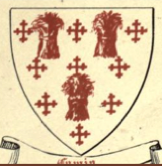
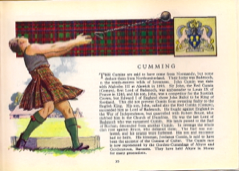
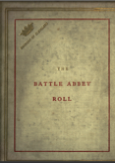
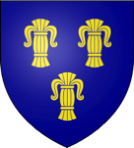
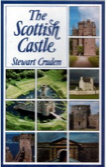
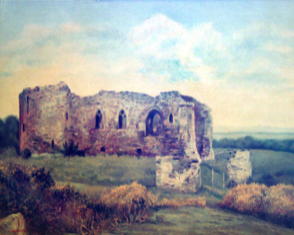
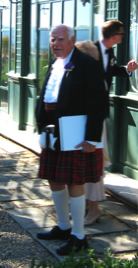
William Chalmers Raitt in Cumming tartan in 2004
THE RAITS OF RAIT CASTLE
Information on the early history of the Raits is found in Steward Cruden’s book, "The Scottish Castle". In his book he states that "The manor (Rait Castle) is first on record in an estate list of 1238. References to Sir Gervaise de Rait and his younger brother, Sir Andrew, are frequent in the last decade of the thirteenth century. Both were well connected in the king’s business, and in 1304 Sir Andrew was employed in a survey of the royal lands of Scotland. This defensible hall-house must be the eponymous manor of the Raits, and of the late thirteenth or early fourteenth century, a likely enough conclusion, architectural evidence concurring with historical probability."
During a visit with Lord and Lady Cawdor, I asked how the Cawdors acquired Rait castle and the Rait lands which are now a part of the Cawdor estate. He replied, "Well, one of yours did in one of ours!" It is their contention and a generally accepted fact that Sir Gervaise de Rait murdered Andrew, the 4th Thane of Cawdor, in 1405. The Campbells of Cawdor then seized half of the Rait lands as indemnification for the slaying and later purchased, according to Lord Cawdor, the remaining half of the lands. There is a rather handsome booklet on Cawdor castle that may be purchased in the castle gift shop. 0n the inside front cover all of the Thanes of Cawdor are listed. There the allegation is made for all the world to see.
Andrew, 4th, murdered by Sir Gervaise de Rait of Rait Castle in 1405.
As I pondered our conversation at a later date it occurred that if Sir Gervaise had been active in 1296 and earlier years as indicated from the records, it would mean that he was well over a hundred years old in 1405 when it is alleged he did Andrew in!! I wrote Lord Cawdor pointing out the discrepancy. He replied as follows: "The date (1405) of the Thane of Cawdor's murder is somewhat vague, and other dates (one I recall was 1380) have been put forward, but I think this year is the most likely on present evidence. There are also different theories about exactly which Rait killed Cawdor. The confusion in dates and names is possibly explicable because there may well have been first names of the same sort in your family over a long period. For instance, we have had, as head of the family, an inordinate number of “Johns”. History tends not to record nicknames; e.g., my father was known as "Jack", so we then know instantly who is referred to. Without these helpful labels histories are confusing."
Lord Cawdor’s explanation is less than convincing to me. I think Sir Gervaise got a bum rapl If the date of 1405 is accepted then it was, obviously another Rait who “did in” the 4th Thane of Cawdor.
Violence and murder were rather frequent during that period of history. The Cummings, including the Raits, were reputedly a quarrelsome lot. The other clans had a rhyme that translated, "so long as there is a stick in the wood, there will be treachery in a Cumming.” Their feuds with the Shaws or Mackintoshes of Clan Chattan are remembered in many a Highland legend. "The main cause of the feud was the two clans rival claims to Rait Castle in Strathnairn, which doubtless arose in the usual way from some family relationship between their two chiefs and a resulting inheritance dispute."
Both were powerful clans, and after many a sanguinary fight they were unreconciled. On one occasion, the chief of the Cummings, under the guise of a desire to bury former animosities and establish friendly relations, invited the Mackintosh and his followers to a grand banquet at Rait. The invitations were accepted, and the Clan Chattan, nothing doubting, prepared to attend. They were, however, timely warned that the Cummings in this had formed a foul plot, and that at a given signal, each Cumming would rise and slay his defenseless guest. When the night of the banquet arrived, each Mackintosh hid his dirk in his plaid, and gayly took his seat at the festive board of Cumming of Rait.
The revelry ran high and the walls of the old castle resounded with the mirthful shouts of the carousers. At length the door of the hall opens, and the shrill strains of the bagpipe for a moment drowns all noises. A ghastly looking figure then enters with a bullocks head on a charger, and the toast is given, "the memory of the dead". This was the signal agreed upon for the slaughter of the guests. The Cummings rose and were about to draw their swords when the Mackintoshes, who, being forewarned were forearmed and with a yell of derision, sprang to their feet, drew their daggers and thrust them into the hearts of the Cummings. Among the few who escaped death, it is said, was the chief of the Cummings, who flew to an upper floor where his daughter was, whom he believed to have given the Mackintosh warning, as he knew that she and the young Mackintosh were secretly lovers. Seeing the maddened state of her father, she sought to escape from him by going through a window, But as she hung from the window, he cut off both her hands with a broadsword and she fell to her death. From that night in which the tragedy was enacted, the bloodstained walls of Rait have been tennantless, except for the oft reported ghost of a handless woman. Her spectre is still seen to this day, according to reports from the local gentry who refer to her as the "Green Lady".
What happened to the Raits? The answer by our informant, Lord Cawdor, was, “As you would say in America, ‘we rode them off the range' and they settled in Angus. This statement is attested to by the fact that there are no Raits or Raitts listed in the telephone book for the Highlands and the Islands. By contrast, there are 46 listed in the Aberdeen and Northeast Scotland area as well as 15 in the Dundee area.
The alleged culprit, Sir Gervaise de Rait, apparently landed rightside up in a place called Hallgreen in The Mearns (see under Other Raitt locations). This is the old name for the present county of Kincardine, which is located in Eastern Scotland, bordering on the North Sea and whose seat is the town of Stonehaven. Sir Gervaise’s son, Mark Rait, married himself an heiress and got with her another estate and another start, founding a family which exists to this day.
HISTORY OF THE CUMMINGS
As noted earlier, the Cummings were of Norman descent and traced their ancestry back to Charlemagne through Robert de Comyn, who was appointed governor of Northumbria (Northern England) in 1068 by his kinsman, William the Conqueror. The first Cumin to settle in Scotland was a powerful Anglo-Norman churchman, William Cumin, a close confidant of the Scottish king, David I (1124-1153) under whom he became Chancellor of Scotland in 1133. His nephew, Richard Cumin, became the progenitor of this Scottish clan.
Feudalism was the European organization of society that had been brought to Britain by the Normans. “Great feudal landowners brought up their own Normanized followers from the South. Under David's grandson, William the Lion (1165-1214), feudalism entered Scotia proper and knights were planted in Angus, Gowrie and Mearns. Probably, in this reign, the family of Comyn came into Badenoch and built up a powerful network of holdings based on the earldom of Buchan, acquired by marriage." In the reign of Alexander III (1249-1286) there were three Cumin earls - Buchan, Monteith and Angus. "During the thirteenth century, the Cummins became the most powerful and patriotic family in all of Scotland."
In 1286, Alexander III fell from his horse and died of a broken neck. The acknowledged inheritor of the kingdom was Margaret, "Maid of Norway”, Alexander's three year old granddaughter, unless the king’s widow should have a child. "The great men of the country appointed a "committee of guardians composed of six nobles and churchmen who were to govern until a ruler should be enthroned. "Two of the committee members were Cumins, one of whom was Sir John, Lord of Badenoch who was known as the "Black Comyn".
After the death of two committee members, the remaining guardians, together with a large body of clergy and nobility, reached an agreement and a treaty was made in 1290 under which Margaret was to come to Scotland to be betrothed to young Edward, the child heir of Edward I of England. The unification of the two crowns could have conceivably resulted in Margaret inheriting the English as well as the Scottish throne since Edward’s own children had had such a high mortality. "The Maid of Norway set out in the late summer but died in Orkney on the way in the arms of the Bishop of Bergen." The two leading candidates for the kingship then became Robert Bruce of Annandale and John Balliol of Galloway. Among the other competitors was the Black Comyn whose claim stemmed from his descent from King Duncan and his marriage to the sister of John Balliol. In 1292 Balliol was proclaimed king. After a stormy four year reign, he was forced to abdicate and fled to France in 1296.
Sir William Gordon-Cumming expressed the opinion that the naming of John Balliol as king was merely a "holding action" until a Cumin could be named as king. John Balliol did not want the job and abdicated as soon as it was feasible to do so.
"With a disputed succession (there were fourteen competitors), something could now be done to clarify things in the English interest. Edward I could now play the game Scottish and English kings had played all through the twelfth century, that of taking advantage of each others weaknesses." Edward's ploy was to transform claims of feudal overlordship into direct
control. A “national feeling already existed, but when men thought in terms of obligation, they thought in feudal terms of fealty, and most of the landowners in Scotland had sworn fealty to Edward. It was difficult to replace this with loyalty to an abdicated and inactive king.”
Following Balliol's abdication, “Edward treated Scotland as a conquered country. Prisoners were taken and sent South as hostages and every man of note was called on to swear fealty in person. (N.B. It was pointed out earlier that Sir Gervaise Cumyn de Raite was present to take an oath of fealty to Edward in 1296 at Elgin.) Scottish records and regalia and, most important of all, the Stone of Destiny on which Scottish kings were enthroned went south is a symbol of conquest." This resulted, naturally, in another revolt, this one led by William Wallace. Years of war between England and Scotland followed. During this period young Robert Bruce of Carrick was named a guardian as was John Comyn of Badenoch, son of the "Black Comyn." He became known as the "Red Comyn." Bruce and the Red Comyn were constantly at odds. Then in February of 1306, Bruce met the Red Comyn in the Greyfriars church at Dumfries. We do not know what plan or proposal was put by Bruce to Comyn, but only that the two men who had been at blows before, fell out, and Bruce stabbed Comyn with a dagger in front of the high altar. His crime had been appalling, the murder of his chief obstacle to his personal ambition in a consecrated place, but he was supported by a wave of national feeling. He rode to Scone and enthroned and crowned as king with as much of the ancient ceremony as could be carried out with several of the Scottish magnates and the Stone of Destiny missing.
As King Robert set out to strengthen his kingship, the Earldom of Buchan, which was Comyn country, became his prime target. He systematically devastated the countryside, mercilessly slaughtering people and cattle. The Red Comyn’s only son was killed at the Battle of Bannockburn in 1314. This marked the end of the Comyn’s influence and power in this part of the country.
“Far to the North on the borders of Badenoch, between the Spey and the Findhorn, a branch of the Cumins continued and became a clan. Their chiefs, the Cummings of Altyre, claim descent from the Red Comyn’s uncle, Sir Robert Comyn, who was slain by Bruce's friends while trying to save his murdered nephew in that fatal church in 1306. They received various grants from King David II and King Robert II, and by the end of the fourteenth century were once again a power to be reckoned with in Moray. It is the Cummings of Altyre, of which the Raitts are, undoubtedly a branch or sept.
There are several statements and opinions to support the contention that the Raitts are Cummings. In the book “The Scottish Castle”, Stewart Cruden states:
"The earliest lords of Rait of whom contemporary records exist took their designation from the manor of Rait, and although nothing certain is known of their origin, they are reputed to have been Comyns.”
Lord Cawdor told us on June 30, 1983 during a conversation with him and Lady Cawdor: "I think there is no question but that the Raits were Cummings.” George Bain in a "Guide to Nairn" further supports this premise saying: “The ruins of the old Castle of Rait are very picturesque. What is known of its history is that it was occupied by Sir Gervaise de Rait and Sir Andrew de Rait, said to be a branch a branch of the Cummings.”
At the suggestion of Lord Cawdor, I wrote Sir William Gordon-Cumming, the present chief of the Clan Cumming, and interestingly, a stepbrother of Lord Cawdor. My question posed to him was whether, in his opinion, the Raits were of this clan. His reply was as follows:
"Raite. First mention of in Edward I’s progress to the North. Sir Gervaise de Rait was present to take an oath of fealty to the king in 1296 at Elgin. He was properly known as Sir Gervaise Cumyn of Raite' The family of Raite (Cumyns) would have used the name of their land as was quite common at that time, and so lost the name Cumyn.
Edward came as far North for one main purpose and that was to subdue the strong faction of the Cumyns. They, however, offered no resistance to his presence till Edward returned to England. Then followed William Wallace’s uprising, his death, and then Robert the Bruce was crowned king in 1306.
Hope this is of interest”
(Signed) William Gordon-Cumming
In May of 1987, Dr. Grant Raitt and I had the opportunity to visit personally with Sir William, the Clan Chieftain, at Altyre, his home in Forres. During our conversation, he stated unequivocally that the Raitts were Cummings. Subsequent to our visit, he sent me a copy of
two pages from an unidentified book, the story of the Cumyn of Raites. As Sir William put it in his letter it is " a little story of our close ties with the Raitts, albeit a sad one." A copy of this very bloody story of Cumyn of Raites is included as an addendum to this paper. Since the Cummings played such an important role in the history of Scotland during the twelfth, thirteenth and early fourteenth centuries, it seems appropriate, at this point, to interject some history of that era and the very significant involvement of the Cummings.
